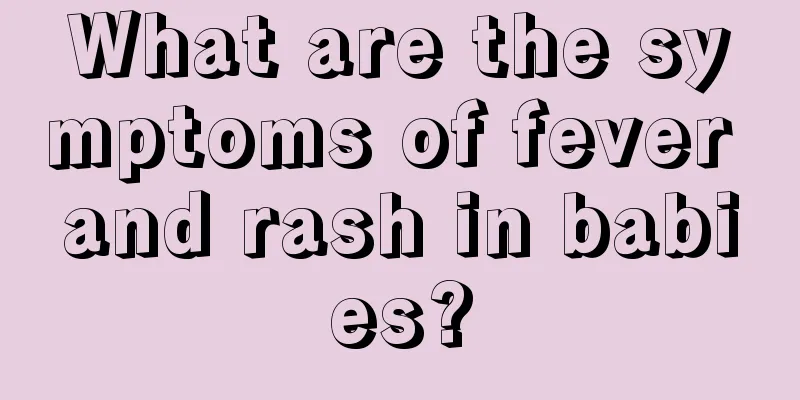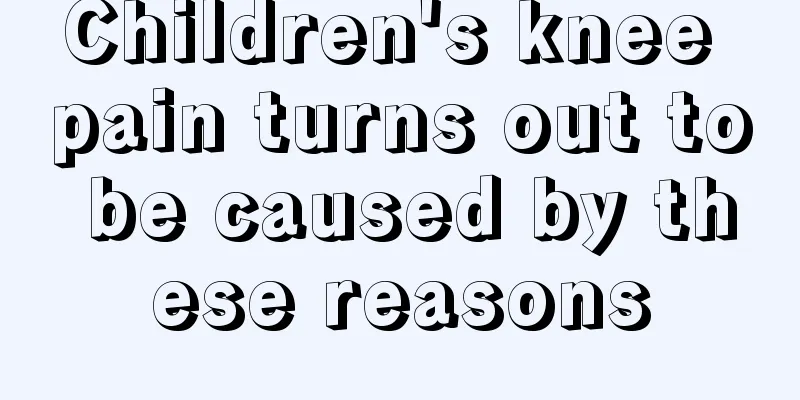What are the symptoms of fever and rash in babies?

|
Rashes are a common disease, which is contagious. After suffering from the rash, timely treatment is needed, otherwise it will threaten the patient's life. Drugs for treating rashes are the best choice, and they are very effective in alleviating the disease. However, it should be noted that the treatment of such diseases must be carried out in isolation. So what are the symptoms of diseases when babies have fever and rashes? The following is a detailed introduction. What are the symptoms of fever and rash in babies? 1. Roseola Roseola usually occurs in children under three years old. It is a viral infection and is also called "roseola infantum" in outpatient clinics. "Rash appears after the fever subsides" is the main characteristic of roseola infantum. After the child has a high fever for 3 to 5 days, the temperature will subside rapidly, and the child's spirit and appetite will gradually recover. But at the same time (about 10 to 20 hours after the temperature subsides), a rash will begin to appear centered on the abdomen. The rash is light pink or red macules (papules) (hence some countries also call it "roseola"), about 2 to 3 mm in diameter, surrounded by a red halo, which fades when pressed. The rash appears within 24 hours, densely on the chest and abdomen, sparsely on the face and limbs, with no obvious itching. It completely disappears within 2 to 3 days, with no pigmentation or desquamation. 2. Scarlet fever The symptoms of scarlet fever are similar to those of a cold or gastroenteritis. It can be transmitted through droplets, usually with fever, sore throat and rash. The rash is in the form of reddish dots that may appear from the neck to the limbs. It feels rough and is prone to occurring in the armpits, neck, groin, etc. The tongue may also develop a so-called strawberry tongue. The rash will appear 1 to 2 days after the fever and will slowly disappear after about 3 days. The best way to prevent it is to practice good hygiene and avoid sharing eating utensils or contact items with others. Once children develop scarlet fever, they must be treated promptly. The basic course of the disease is one week. They must be isolated and should not go out again for about three days after recovery. Get enough rest, eat a light diet, and drink plenty of water. Exercise more often to enhance your body's immunity, do more outdoor sports, avoid catching a cold, and keep the room ventilated. 3. Measles Measles is a highly contagious viral disease with the main symptoms of fever, runny nose, cough, conjunctival congestion, Koplik spots on the oral mucosa and red maculopapular rash on the skin; complications such as pneumonia, laryngitis, and encephalitis may occur; severe cases can be fatal. Measles patients can expel the virus through sneezing, coughing, etc. and infect susceptible people. my country currently implements a two-dose immunization program for children containing measles vaccines: one dose of measles vaccine at 8 months of age and one dose of measles-mumps-rubella vaccine at 18 to 24 months of age. For other people who have not contracted measles and have no history of measles vaccination or whose measles vaccination history is unknown, it is recommended to receive one dose of measles-rubella live attenuated vaccine. 4. Chickenpox From early winter to severe winter, it is the peak season for chickenpox in children. Children will not develop chickenpox immediately after being infected. The incubation period of chickenpox in children is usually around 14 to 21 days. Moreover, the early symptoms of chickenpox are very similar to those of a cold, and usually there are two or three days of cold symptoms, making it difficult for parents to distinguish. When a child gets chickenpox, his or her whole body will show signs of discomfort, such as fever, which will not be too high, about 38℃ ~ 38.5℃; it may be accompanied by cough or diarrhea, poor appetite and spirit; at the same time as the fever or 1 to 2 days after, the child's skin will itch. First, red dots the size of rice grains appear. After a few hours or a day, the small red rashes will turn into blisters the size of soybeans or mung beans, containing liquid and surrounded by red halos. After about 1 to 2 days, the blisters begin to become turbid and sunken. After 3 to 4 days, the blisters dry up and begin to scab over. Babies often have chickenpox on their trunk and less on their limbs, head and face, and may also have complications such as papules and herpes. Giving your baby regular vaccinations can help produce antibodies and prevent chickenpox infection. After understanding the symptoms of diseases that cause fever and rash in babies, the treatment of such diseases should also be based on the patient's symptoms. Moreover, when the baby suffers from such a disease, parents should always pay attention to the child's condition. If any abnormal changes occur, they should be reported in time to avoid further impact on the child's body. This is something to pay attention to. |
<<: What causes dark eye bags in children?
>>: How to increase children's immunity?
Recommend
Redness inside the nostrils of a newborn
The inside of the nostrils of a newborn baby beco...
What should I do if my child has a toothache and a swollen face?
Children will encounter many problems as they gro...
What is the baby appetizer recipe?
When the baby has a poor appetite, it always make...
What causes black spots on baby's face?
However, when many mothers are taking care of the...
What are the scientific methods to help children grow taller?
I believe every parent hopes that their child can...
How long does it usually take for a newborn to grow teeth?
Having a child in the family really adds a lot of...
Intestinal polyps in children
Intestinal polyps may occur in a variety of peopl...
What to do if abo hemolysis occurs in newborns
What to do if neonatal ABO hemolytic disease occu...
What should I do if my baby has a heavy tongue coating?
Many babies have the problem of thick tongue coat...
At what months can babies crawl?
The arrival of a newborn means that a life has co...
Does hand, foot and mouth disease cause red spots all over the body?
The physical condition of the baby has always bee...
Children's vaccination schedule introduction
People who have babies at home know that babies h...
What should I do if my child hunches over?
Many children have strange walking postures becau...
How to make delicious baby wonton skin
The baby's nutritional intake is an issue tha...
What to do if a 6-year-old child has tooth decay
Most of the time, when children experience tooth ...









